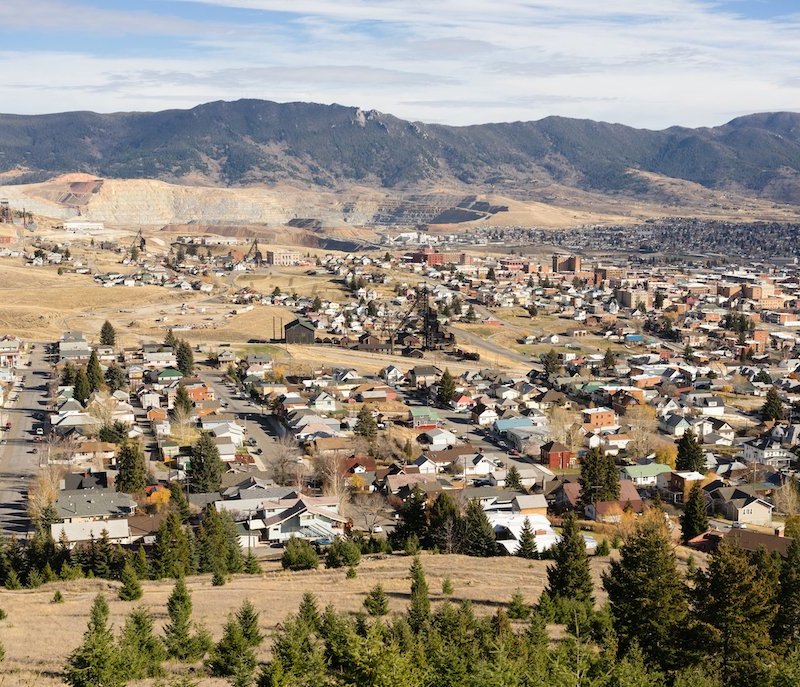
Butte, Montana, has a rich history — both literally and figuratively. Nestled against the continental divide in the Rocky Mountains, Butte boomed in the 1800s with the discovery of gold. Overnight Butte’s population swelled with miners, merchants, saloon keepers, and madams flocking to the boomtown. And they came from Finland, Serbia, Lebanon, China, Italy, and Ireland.
Videos by TravelAwaits
Those from Ireland left many descendants. According to the 2010 census, Butte had more people of Irish descent per capita than any place in the U.S.
Miners discovered gold first, then silver. They both paled in comparison to the discovery of copper — and it couldn’t have come at a better time as copper electrical wires spread across America in the 1890s. Butte, in fact, had electricity before New York City.
Today Butte’s population is a third of what it was in its heyday — hovering around 35,000 people. Fourteen headframes are scattered in and around Butte, each standing above a defunct mine. As the price of copper declined, Butte’s mining and population declined.
Butte’s main industry is now tourism. It’s eager to share the town’s rich history of mining, millionaires, and immigrants in an amazing array of attractions and experiences. Let’s take a look:

1. Explore The World Museum of Mining
Whether you opt for a mine tour — through an actual mine shaft — or stay above ground with a docent-led tour with time to explore on your own, the World Museum of Mining is a must-see in Butte. It sets the stage for your entire visit to the city.
Museum displays give you a feel for what a day in the life of a miner felt like. The massive headframe you see lowered men and mules in a shockingly small car 2,700 feet below ground level for their day’s work and ore out.
For a glimpse of life during the late 1800s, the Hell Roarin’ Gulch exhibit is a mining town with 15 historic buildings and 35 re-created buildings. The buildings house thousands of artifacts and give you a feel for life above ground in a mining boomtown.
In case you’re wondering about how perilous life was as a miner, you need to look no farther than the Honor Wall, with more than 2,500 miners’ names etched on its black granite walls.
Pro Tip: The underground tour is not ADA accessible. It is a walking tour that takes you 100 feet below ground on a fairly steep path lit by your headlamp. Closed-toe shoes and jackets, even during the summer, are recommended. Allow 2 to 3 hours for your visit.
2. Be Dazzled At The Mineral Museum
Excuse the pun, but the Mineral Museum is a true gem. Located on the Montana Technical University (formerly the School of Mines) campus, this donation-only museum showcases a wide array of gems, minerals, and fossils. What began as a specimen collection to teach students has grown to contain more than 12,000 samples through generous donations of entire collections.
Here you’ll see gems collected only within the state, Yogo sapphires. They are considered the most precious sapphires in North America and have a deep blue color. Miners in search of gold discovered them in central Montana’s Yogo Gulch. And you can’t miss the Rheanna Star, a conglomeration of smoky quartz crystals measuring 2 feet across, discovered in Butte.
On the other end of the spectrum distance-wise, the museum has a collection of meteorites that have crash-landed on Planet Earth.
Pro Tip: The gift shop sells copper coins and copper cubes that make for unique souvenirs. The museum is ADA accessible. Allow an hour for your visit.
3. View The Berkeley Pit
Three men who made their fortunes mining copper claimed Butte was built on the richest hill on earth. At the turn of the 19th century, these men, called the Copper Kings, pulled so much copper ore out of mines that Butte was the wealthiest city in America.
Eventually, open-pit copper mining replaced mining in tunnels, as you learn at the Mining Museum. Today, you can view the remnants of an open-pit mine on a Berkeley Pit Viewing Stand. The pit measures 7,000 feet long, 5,600 feet wide, and 1,600 feet deep. The mine yielded 290 million tons of copper ore. When the mine closed in 1982, the pit filled with acidic, toxic-waste-laced water. Thanks to a $150 million superfund, the water level is dropping.
Pro Tip: Allow 30 minutes for your visit. The observation deck is ADA accessible.

4. Visit Our Lady Of The Rockies
Bob O’Bill, grateful for his wife’s recovery from cancer, built the statue with the help of volunteers as a tribute to Jesus’ mother, Mary, to whom he prayed. Over the course of 6 years, volunteers funded and built the 90-foot statue. It’s currently the 3rd tallest statue in the U.S.
Our Lady of the Rockies stands atop the Continental Divide overlooking Butte. Constructed in sections, members of the Nevada Air National Guard transported and assembled the metal sculpture on its concrete base in 1985.
The only way to visit the statue is by booking a tour, as no private vehicles are allowed on the access road.
Pro Tip: Allow 2.5 hours for your ADA-accessible tour.

5. Learn About Butte’s Chinatown
Mai Wah Museum pays tribute to the Chinese immigrants who came to the area as miners, merchants, and workers in service industries. A minority were miners. Most of them fled China’s Taiping Rebellion beginning in 1840, seeking a better life in America.
The museum is housed in the historic Wah Chong Tai Company and Mai Wah Noodle Parlor, side by side buildings. The Wah Chong Tai Company was once a mercantile. Display cases and merchandise are original, making this museum one of the most complete Chinese stores from the early 20th century.
The museum is located in what was once a bustling Chinatown, complete with underground passageways, opium dens, and gambling parlors. Artifacts uncovered from an archeological dig in Chinatown are displayed in the museum.
Pro Tip: The ground floor of the museum is ADA accessible. Allow 1 to 2 hours for your visit.
6. Eat Chop Suey
Pekin Noodle Parlor is right around the corner from Mai Wah Museum. You’ll know you’ve arrived when you see the vintage Chop Suey sign. It happens to be the oldest, continuously operating Chinese restaurant in the U.S., entering its 110th year and surviving its second pandemic. The family-run restaurant is in its fifth generation.
It is unlike any restaurant you’ve seen with original tangerine-colored beadboard creating cubicles ideal for social distancing. You can’t go wrong with the curry.
Pro Tip: Steep steps lead to the restaurant that doesn’t open until 5 p.m.

7. Stay At The Copper King Mansion
Once a private home, Copper King Mansion is now a bed and breakfast and open for guided tours. William A. Clark had this Victorian mansion built in 1884. You’d never know by looking at it that Clark began his life in Montana as a gold miner and ended up being one of three Copper Kings, as they are called today. From miner to mine owner to entrepreneur, Clark amassed a fortune mining copper and owning railroads, electric power companies, newspapers, and banks. He was worth $200 million, in conservative estimates, by the time he died in 1925.
Whether you spend the night or take a guided tour, the house’s crowning glory is a 7- by 13-foot stained glass window that bathes the entry’s grand staircase in soft light. Cherry and cypress wood parquet floors, handsome oak paneling, mahogany fireplaces, and hand-painted frescoes on the ceilings all speak to Clark’s wealth. Priceless antiques fill the rooms.
If you spend the night, breakfast is served in the main dining room with a unique ceiling — gold-embossed leather rimmed with hand-painted murals.
Pro Tip: The bed and breakfast is open year-round. With only six guest rooms, make reservations well in advance for the summer months. Guided tours, free for overnight guests, are offered daily in the summer and by appointment off-season.
8. Pay Your Respects To Evel Knievel
Motorcycle stuntman and entertainer Robert — Evel — Knievel was born in Butte in 1938. The daredevil attempted 75 jumps. Some he made, some he didn’t. He broke dozens of bones. He died in 2007 and is buried in Butte’s Mountain View Cemetery. He lies beneath a tombstone made in 1974, just in case he died while jumping over Idaho’s Snake River Canyon.
9. Attend A Festival
Butte is Montana’s festival city, in large due to its history as a city of immigrants. Butte celebrates Chinese New Year, Serb Fest, and An Ri Ra — an Irish festival. Butte also hosts the Montana Folk Festival each summer. It draws musicians and fans for 3 days of free concerts in July.
But given the large percentage of people of Irish descent in Butte, the granddaddy of all celebrations is on St. Patrick’s Day. The day begins with a parade through Butte’s historic district with pipers and kilt-wearing bagpipe players and ends with lots of pinches if you forget to wear green.
Pro Tip: If you intend to spend the night during St. Patrick’s Day or the Montana Folk Festival, reserve your room early.
Related Articles:
- From Dinosaurs To Homesteaders: 7 Great Historical Museums In Southeastern Montana
- Why We Can’t Stop Dreaming About Montana
- The Best Things To See And Do In Missoula, Montana
- Beautiful Montana Road Trip: Billings To Missoula
- Whitefish, Montana: The Best Things To See And Do
- The Best Things To Do In Intriguing Cut Bank, Montana
